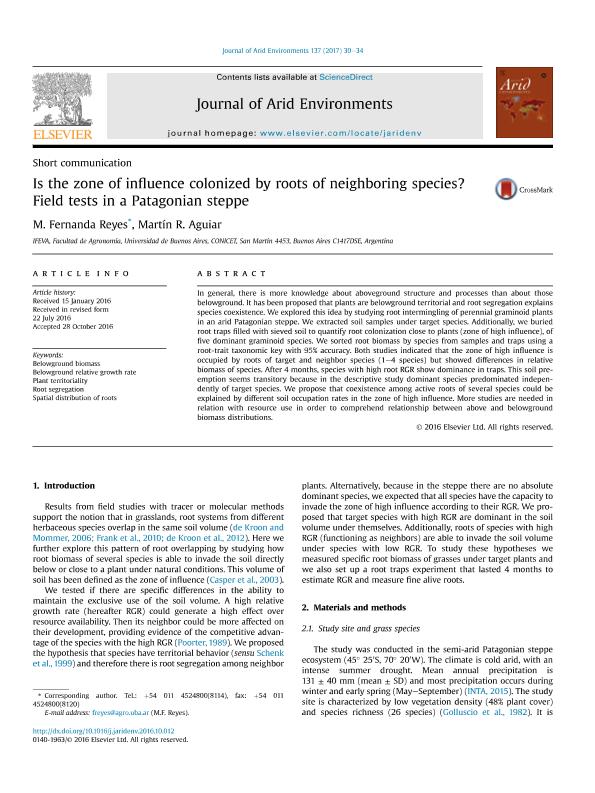Mostrar el registro sencillo del ítem
dc.contributor.author
Reyes, María Fernanda

dc.contributor.author
Aguiar, Martin Roberto

dc.date.available
2018-08-21T14:48:08Z
dc.date.issued
2017-02
dc.identifier.citation
Reyes, María Fernanda; Aguiar, Martin Roberto; Is the zone of influence colonized by roots of neighboring species? Field tests in a Patagonian steppe; Academic Press Ltd - Elsevier Science Ltd; Journal of Arid Environments; 137; 2-2017; 30-34
dc.identifier.issn
0140-1963
dc.identifier.uri
http://hdl.handle.net/11336/56310
dc.description.abstract
In general, there is more knowledge about aboveground structure and processes than about those belowground. It has been proposed that plants are belowground territorial and root segregation explains species coexistence. We explored this idea by studying root intermingling of perennial graminoid plants in an arid Patagonian steppe. We extracted soil samples under target species. Additionally, we buried root traps filled with sieved soil to quantify root colonization close to plants (zone of high influence), of five dominant graminoid species. We sorted root biomass by species from samples and traps using a root-trait taxonomic key with 95% accuracy. Both studies indicated that the zone of high influence is occupied by roots of target and neighbor species (1–4 species) but showed differences in relative biomass of species. After 4 months, species with high root RGR show dominance in traps. This soil pre-emption seems transitory because in the descriptive study dominant species predominated independently of target species. We propose that coexistence among active roots of several species could be explained by different soil occupation rates in the zone of high influence. More studies are needed in relation with resource use in order to comprehend relationship between above and belowground biomass distributions.
dc.format
application/pdf
dc.language.iso
eng
dc.publisher
Academic Press Ltd - Elsevier Science Ltd

dc.rights
info:eu-repo/semantics/openAccess
dc.rights.uri
https://creativecommons.org/licenses/by-nc-sa/2.5/ar/
dc.subject
Belowground Biomass
dc.subject
Belowground Relative Growth Rate
dc.subject
Plant Territoriality
dc.subject
Root Segregation
dc.subject
Spatial Distribution of Roots
dc.subject.classification
Otras Ciencias Biológicas

dc.subject.classification
Ciencias Biológicas

dc.subject.classification
CIENCIAS NATURALES Y EXACTAS

dc.title
Is the zone of influence colonized by roots of neighboring species? Field tests in a Patagonian steppe
dc.type
info:eu-repo/semantics/article
dc.type
info:ar-repo/semantics/artículo
dc.type
info:eu-repo/semantics/publishedVersion
dc.date.updated
2018-08-16T15:10:38Z
dc.journal.volume
137
dc.journal.pagination
30-34
dc.journal.pais
Países Bajos

dc.journal.ciudad
Amsterdam
dc.description.fil
Fil: Reyes, María Fernanda. Consejo Nacional de Investigaciones Científicas y Técnicas. Oficina de Coordinación Administrativa Parque Centenario. Instituto de Investigaciones Fisiológicas y Ecológicas Vinculadas a la Agricultura. Universidad de Buenos Aires. Facultad de Agronomía; Argentina
dc.description.fil
Fil: Aguiar, Martin Roberto. Consejo Nacional de Investigaciones Científicas y Técnicas. Oficina de Coordinación Administrativa Parque Centenario. Instituto de Investigaciones Fisiológicas y Ecológicas Vinculadas a la Agricultura. Universidad de Buenos Aires. Facultad de Agronomía; Argentina
dc.journal.title
Journal of Arid Environments

dc.relation.alternativeid
info:eu-repo/semantics/altIdentifier/doi/https://dx.doi.org/10.1016/j.jaridenv.2016.10.012
dc.relation.alternativeid
info:eu-repo/semantics/altIdentifier/url/https://www.sciencedirect.com/science/article/pii/S0140196316301999
Archivos asociados
